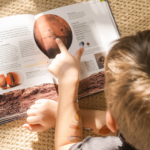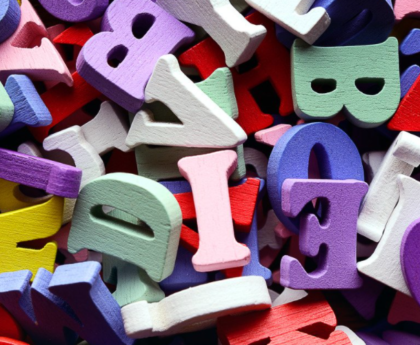As parents, navigating educational standards can feel overwhelming, especially when it comes to something as fundamental as reading. Let’s break down the specific Common Core reading standards for Pre-K and early elementary students and explore practical activities that align with these standards to support your child’s reading journey.
Key Common Core Reading Standards for Early Elementary
The Common Core State Standards for Reading are organized into several key areas. For PreK-2nd grade, these include:
Print Concepts
These standards focus on understanding how books and print work.
Kindergarten standards require students to:
- Follow words from left to right, top to bottom, and page by page
- Recognize that spoken words correspond to written sequences of letters
- Understand that words are separated by spaces
- Recognize and name all letters of the alphabet
1st Grade standards build on these concepts by having students:
- Recognize features of a sentence (first word, capitalization, ending punctuation)
Phonological Awareness
These standards address the ability to hear and manipulate sounds in spoken words.
Kindergarten standards expect students to:
- Recognize and produce rhyming words
- Count, blend, and segment syllables
- Blend and segment onsets and rimes
- Isolate initial, medial, and final sounds in simple words
- Add or substitute sounds to make new words
1st Grade standards progress to:
- Distinguish long from short vowel sounds in spoken words
- Blend sounds, including consonant blends
- Isolate and pronounce sounds in single-syllable words
- Segment words into their complete sequence of individual sounds
Phonics and Word Recognition
These standards cover the relationship between letters and sounds.
Kindergarten standards require students to:
- Produce primary sounds for each consonant
- Associate long and short sounds with common vowel spellings
- Read common high-frequency words by sight
- Distinguish between similarly spelled words
1st Grade standards advance to:
- Know spelling-sound correspondences for common consonant digraphs
- Decode regularly spelled one-syllable words
- Know final -e and vowel team conventions for long vowel sounds
- Understand that every syllable must have a vowel sound
- Decode two-syllable words by breaking them into syllables
- Read words with inflectional endings
- Recognize irregularly spelled words
2nd Grade standards continue with:
- Distinguishing long and short vowels in regularly spelled words
- Knowing additional vowel team correspondences
- Decoding two-syllable words with long vowels
- Decoding words with common prefixes and suffixes
- Identifying words with inconsistent spelling-sound patterns
Fluency
These standards address the ability to read with accuracy, speed, and expression.
Kindergarten standards focus on:
- Reading emergent texts with purpose and understanding
1st and 2nd Grade standards expand to:
- Reading grade-level text with purpose and understanding
- Reading orally with accuracy, appropriate rate, and expression
- Using context to confirm or self-correct word recognition
Align with Reading.com’s Approach
Reading.com‘s approach to literacy development directly supports the Common Core standards through:
- Systematic Phonics Instruction: Just as the standards emphasize explicit phonics instruction in a specific sequence, Reading.com teaches letter-sound relationships systematically rather than randomly.
- Balanced Skill Development: The standards require development across multiple skill areas, and Reading.com addresses all five fundamental reading components: phonemic awareness, phonics, fluency, vocabulary, and comprehension.
- Personalized Learning: Common Core standards provide grade-level expectations, but recognize that children develop at different rates. Reading.com’s app assesses your child’s current abilities and tailors instruction to their needs.
- Parent Involvement: The standards assume active adult guidance, especially in the early grades. Reading.com encourages parent participation as an essential component of reading success.
- Evidence-Based Methods: Both Common Core and Reading.com reject the outdated “three-cueing system” (guessing words from context or pictures) in favor of teaching children to decode text systematically.
Grade-Specific Guidance
Let’s talk through how you can, at home, support your growing reader in a way that aligns with classrooms that use Common Core.
For Parents of Kindergartners:
Focus on letter recognition, letter-sound relationships, and concepts about print. Your child should be developing an understanding that letters represent sounds and that print carries meaning. The Common Core standards specifically mention developing these skills through read-alouds with purpose and understanding.
For Parents of 1st Graders:
Your child is now expected to decode simple words independently. The standards emphasize phonics skills like recognizing consonant digraphs, understanding final -e rules, and reading words with inflectional endings (-s, -ed, -ing). Regular practice with decodable texts that match their phonics knowledge is essential.
For Parents of 2nd Graders:
The standards now expect more advanced decoding skills, including words with common prefixes and suffixes. Fluency becomes increasingly important, with standards specifically mentioning accuracy, appropriate rate, and expression. Your child should be reading grade-level text with understanding and using context to self-correct when needed.
Monitor Progress Through Common Core Milestones
The standards provide clear benchmarks for each grade level. Here are key indicators that your child is on track:
By the end of Kindergarten, your child should:
- Name all upper and lowercase letters
- Match most letters to their sounds
- Recognize and produce rhyming words
- Read common high-frequency words (the, of, to, you, she)
- Retell familiar stories with key details
By the end of 1st Grade, your child should:
- Decode regularly spelled one-syllable words
- Read words with common endings (-s, -ed, -ing)
- Use phonics skills to sound out unfamiliar words
- Read grade-level text with purpose and understanding
- Retell stories with a central message or lesson
By the end of 2nd Grade, your child should:
- Distinguish between long and short vowels when reading
- Decode two-syllable words with long vowels
- Read words with common prefixes and suffixes
- Read grade-level text with accuracy, appropriate rate, and expression
- Recount stories and determine their central message or moral
Support Reading Development Beyond Standards
While meeting standards is important, remember that developing a love of reading is equally valuable:
- Balance structured practice with enjoyment: After working on specific skills, spend time reading purely for pleasure.
- Connect reading to interests: Find books about topics your child loves, whether it’s dinosaurs, space, animals, or sports.
- Create reading routines: Establish consistent daily reading times where you read to your child, they read to you, and they read independently.
- Celebrate progress: Acknowledge your child’s reading achievements, no matter how small, to build confidence and motivation.
Reading.com: Support Common Core Success
The Reading.com app aligns with Common Core standards by providing:
- Systematic phonics instruction in the sequence outlined by the standards
- Activities that develop all five key reading components
- Personalized assessment and instruction
- Parent involvement opportunities
- Engaging, game-based practice that makes meeting standards fun
By understanding the specific Common Core reading standards for your child’s grade level, you can provide targeted support at home that complements classroom instruction. The standards create a roadmap for reading development, and with the right tools and approaches, you can help your child navigate this journey successfully.
Start your free 7-day trial of the Reading.com app today and discover how our research-backed approach can help your child read with joy.





